New Partner Program Structure Simplifies Ericsson Enterprise Wireless Engagement
Ericsson has introduced a refreshed Solutions Partner Program for its Enterprise Wireless division, aiming to streamline how partners sell and support its Enterprise Wireless Solutions portfolio. This updated program replaces the previous tiered structure with a clearer, more flexible framework designed to increase earning opportunities, expand enablement, and reward partner expertise more effectively.
Enhanced Deal Registration Increases Partner Revenue Opportunities
One of the core enhancements is an upgraded deal registration process. Partners can now unlock greater discounts and enjoy stronger protection for registered deals compared to opportunities pursued without registration. The updated guidelines also cover leads and opportunities generated directly by Ericsson, offering partners an extra layer of security when closing business.
New Partner Tiers Support Diverse Wireless Solutions Models
The new Solutions Partner Program includes three key partner categories:
- Solution Partners: A unified track for resellers who commit to sales and technical certifications and build dedicated practices around Ericsson Enterprise Wireless Solutions.
- Distribution-Managed Partners: Resellers working through distributors with programmatic backing to access tools and support.
- Ecosystem Member Partners: Managed Service Providers (MSPs), carriers, and technology alliance members who build services or technologies around Ericsson’s Enterprise Wireless portfolio.
Mountaineer Program Expansion Strengthens Partner Enablement
Ericsson has also upgraded its Mountaineer Program. Open to all partners, this initiative delivers training and certifications to accelerate technical adoption and foster innovative uses of Enterprise Wireless Solutions. Beyond technical users, the Mountaineer Program now includes incentives for sales and support teams, with more roles set to be added soon. Different Mountaineer expertise levels help partners unlock additional benefits as they advance.
Partner View Tool Delivers Clear Wireless Program Insights
Partners will now gain access to Partner View — a centralized tool offering a clear, single view of key performance metrics. With Partner View, partners can track revenue, certifications, training progress, and sales pipeline data all in one place.
Matt Cook, Head of Sales, Go-to-Market & Support for Enterprise Wireless Solutions at Ericsson, explained the goal behind the revamp: “We’re focused on helping our partners build stronger businesses around our Enterprise Wireless Solutions. The new program not only improves financial incentives but also strengthens our collaboration to deliver better services to end-users.”
He added, “With Partner View, both Solution Partners and our Partner Account Managers can spend less time gathering data and more time putting it to use.”
Ericsson Enterprise Wireless Partner Program Launch & Next Steps
The updated Enterprise Wireless Solutions Partner Program went live on July 1, 2025. Ericsson encourages all partners to connect with their Partner Account Managers to learn more about eligibility, benefits, and how to get started with the new tools and resources available.







































